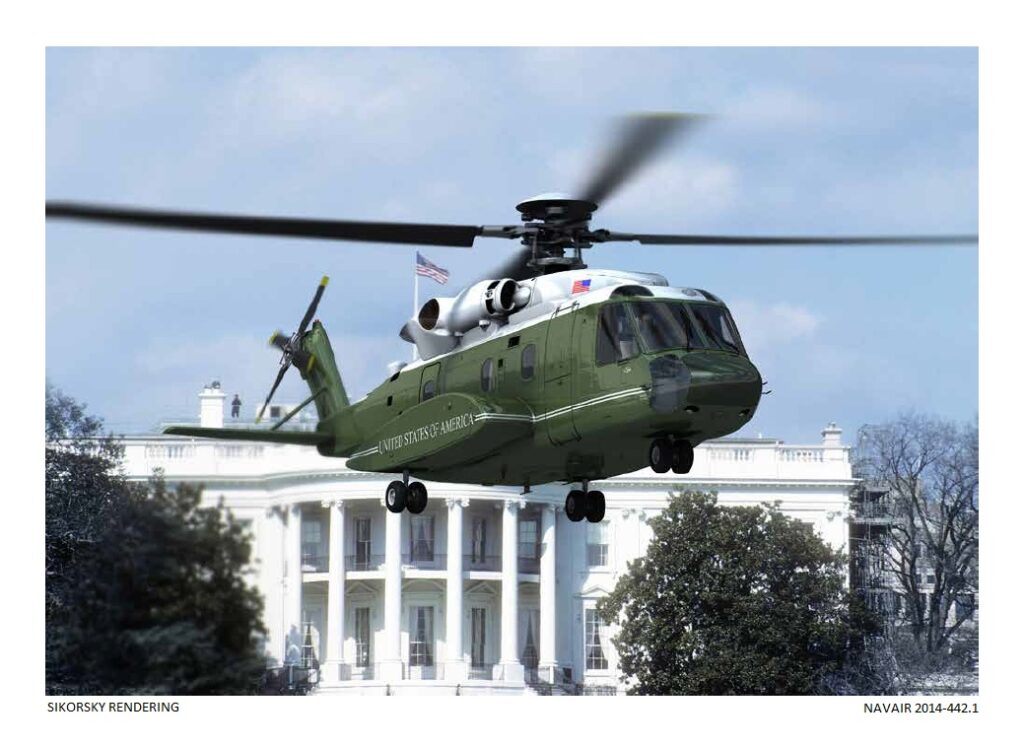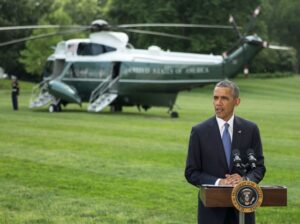Marine One, Take 2: No New Bright Ideas!
Posted on

A Sikorsky drawing of their H-92 helicopter in its future role as “Marine One.”
VIRGINIA BEACH, VA.: The new presidential helicopter made its first flight in December, the Marine Corps colonel in charge of the program revealed this morning. That was only seven months after contract award, a stark contrast to the multi-year delays that killed the previous program, the VH-71.
But don’t get too excited. No miracles are afoot. Sikorsky Aircraft Corp. simply flew one of its S-92 commercial helicopters to a Lockheed Martin facility in Owego, New York, that will turn the aircraft into the next Marine One by installing special avionics and communications gear.
“With the comms system, there’s a lot of antennas on this aircraft,” said Col. Robert Pridgen in a briefing to the American Helicopter Society International’s annual forum here. They have to be tested to be sure they operate correctly on this Engineering and Development Model (EDM) of what will become the VH-92. “That’s the integration and the test work that’s going on now,” Pridgen said. “On or about the second to last week of this month, we’ll be flying that aircraft again to continue its testing.”
Ho hum as that may sound, things are moving swiftly on the rebooted presidential helicopter replacement program. Its predecessor, VH-71 — a derivative of the AgustaWestland EH101 — was killed in 2009 by then-Defense Secretary Robert Gates after its estimated cost doubled to $13 billion and it fell six years behind schedule. By August, the rebooted program plans to hold a formal Preliminary Design Review to validate details of the modifications Lockheed is making to the S-92. A second EDM aircraft is expected to arrive 30 to 45 days ahead of schedule. By 2020, the first of 21 more planned VH-92s should be ready for service.
“The aircraft is off and running,” said Pridgen. And not a moment too soon. HMX-1, the Marine Corps squadron that flies the president and handles other White House helicopter needs, has a total of 19 green and white VH-60N “Whitehawks” and VH-3D Sea Kings. It’s the Sea Kings that take turns as the familiar Marine One — a designation only used when the president is aboard — that lands on the back lawn at 1600 Pennsylvania Avenue. The VH-60s reached Initial Operational Capability in 1989. The VH-3 has been in service since 1974.

President Obama backed by one of the aging Sea King helicopters that serves as Marine One.
“We do have one of President Nixon’s aircraft that’s in our inventory,” Pridgen said.
The VH-71’s failure is partly to blame, but a lesson learned from that fiasco is one reason the far simpler VH-92 program is off to such a good start. Put simply, the VH-71 died of requirements creep, a sickness the VH-92 program is determined to avoid.
“What happened on the last program was, anybody was allowed to bring their favorite requirement to the table,” said Rear Adm. Cindy “C.J.” Jaynes, the Naval Air Systems Command (NAVAIR) program executive officer who oversees Navy and Marine rotorcraft programs. “The cost just grew out of control.”
So did the schedule, added Pridgen, because adding requirements added weight to the EH-101, which invalidated its Federal Aviation Administration certification. Program officials think their determination to avoid recertification is why the Sikorsky and Lockheed team, who won the $1.24 billion contract a year ago this month, was the only bidder.
“We believe the reason there was only one bidder was because you had to meet the structural requirements of the aircraft,” said Jaynes. “It had to be a certain footprint. It had to be presidential. You had to be able to walk into the aircraft. We did not want to make any structural changes to the aircraft because then we would invalidate the FAA certification. “
In the new program, the S-92’s FAA certification is being used as an immutable benchmark. The S-92 is a 27,000 lb. aircraft (gross weight) and won’t be growing, Pridgen vowed. Even if Pridgen were to agree that a proposed new requirement was a good idea, Jaynes and other leaders with stars on their shoulders would have to approve.
“We understand our requirements,” Pridgen said. “We have the structure in place that maintains that discipline. I’ve got to go through the admiral and a few other people here if the ‘good idea machine’ kicks in.” Instead, Pridgen vows that, by 2020, “You will see a new aircraft on the lawn.”
Subscribe to our newsletter
Promotions, new products and sales. Directly to your inbox.
